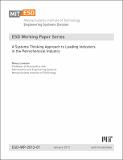| dc.description.abstract | There are always warning signs before a major accident, but these signs may only be noticeable or interpretable as a leading indicator in hindsight. Before an accident, such “weak signals” are often perceived only as noise. To ask people to “be mindful of weak signals” is asking them to do something that is impossible. There is always a lot of noise and always a lot of signals that do not presage an accident. The problem then becomes how to distinguish the important signals from all the noise. Defining effective leading indicators is a way to accomplish this goal by providing specific clues that people need to look for. Asking people to “look for anything that might be an important sign” is usually asking them to do the impossible.
Almost all of the past effort to identify leading indicators has involved finding a set of generally applicable metrics or signals that presage an accident. Examples of such identified leading indicators are quality and backlog of maintenance, inspection, and corrective action; minor incidents such as leaks or spills, equipment failure rates, and so on. There is commonly a belief—or perhaps, hope—that a small number of such “leading indicators” can identify an increase in risk of an accident. While some general indicators may be useful, large amounts of effort over decades has not provided much progress. The lack of progress may be a sign that such general, industry-wide indicators do not exist or will not be particularly effective in identifying increasing risk. An alternative is to identify leading indicators that are specific to the system being monitored.
This paper proposes an approach to identifying and monitoring system-specific leading indicators and provides some guidance in designing a risk management structure to use such indicators effectively. The approach is based on the STAMP model of accident causation and tools that have been designed to build on that model. STAMP extends current accident causality to include more complex causes than simply component failures and chains of failure events. It incorporates basic principles of systems thinking and is based on systems theory rather than traditional reliability theory. The next section briefly describes STAMP and STPA, the latter being a new hazard analysis technique based on STAMP. Then the proposal for a new approach to generating and managing leading indicators is outlined. | en_US |
